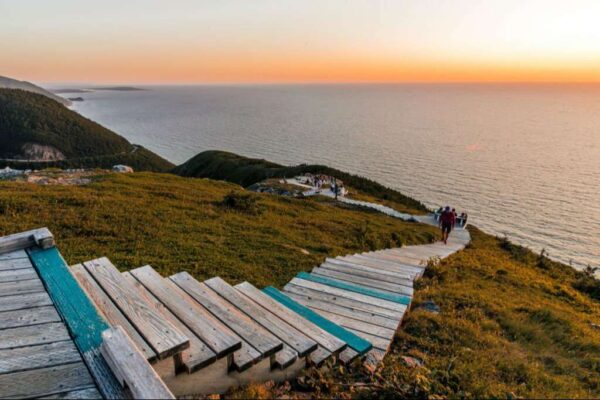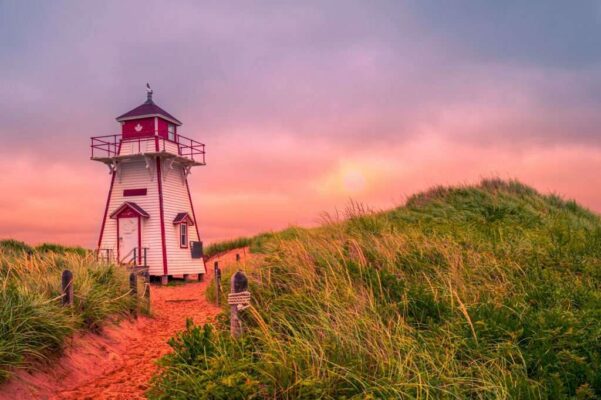It is widely known that one of the primary motivations for people to visit Canada is the opportunity to venture into the nation’s stunning, unspoiled wilderness. The iconic imagery of the Great White North often features snowy mountains, expansive forests, and vibrant glacial lakes. These are precisely the landscapes you will encounter when you embark on a journey to explore the finest national parks in Canada.
To assist you in savoring the best that Canada has to offer, we’ve compiled a list of the country’s premier national parks, each possessing its own unique allure.
Banff National Park

Banff National Park claims the top spot on this list, and it is no wonder why. As the most renowned and frequently visited national park in Canada, this majestic wilderness nestled in the Alberta Rocky Mountains stands as a cherished and iconic landmark. Established in 1885, Banff holds the distinction of being the oldest national park in Canada and is a key component of the Canadian Rockies UNESCO World Heritage site.
What sets Banff apart is its harmonious blend of the snow-draped peaks of the Rockies and the enchanting blues of lakes such as Lake Louise and Moraine Lake. Serving as a haven for outdoor enthusiasts, the park offers a plethora of activities, including hiking and horseback riding in the summer, and skiing and snowboarding in the winter.
Read More: Top Tourist Attractions in Banff National Park
Gros Morne National Park

Nestled on the west coast of Newfoundland, Gros Morne National Park is a true gem, boasting majestic fjords and a captivating range of landscapes. Spanning a vast territory of 1,805 square kilometers, the park offers diverse terrains, from towering mountains and secluded beaches to expansive bogs.
This ever-shifting scenery creates an ideal haven for hiking enthusiasts, making it possibly the ultimate destination for multi-day treks among Canada’s national parks. The standout features of this UNESCO World Heritage Site include the stunning fjords like Western Brook Pond Fjord and the Tablelands, a rare geological phenomenon featuring rocks from the Earth’s crust.
Wapusk National Park

Heading into the remote expanses of northeast Manitoba, we encounter Wapusk National Park. Established in 1996, this relatively young park is situated along Hudson Bay, south of the town of Churchill. The name “Wapusk” derives from the Cree language, meaning polar bear, which is fitting as the park is renowned as one of the premier spots globally for observing wild polar bears. In this incredibly isolated region of Canada, you’ll also find other wildlife such as moose, wolves, and arctic foxes. Accessing Wapusk National Park poses a challenge akin to discovering its wildlife, with helicopters being the sole means to reach certain areas, like Cape Churchill.
Yoho National Park

Spanning a vast region, the Rocky Mountains traverse numerous parks on this list, including Yoho National Park. Situated adjacent to Banff National Park, this British Columbia national park was established in 1886, just a year after Banff. Yoho National Park showcases many iconic elements of the Canadian Rockies, featuring breathtaking lakes, formidable mountains, and boundless opportunities for hiking. Among the park’s most captivating attractions are the Burgess Shale fossils, which date back 508 million years, predating even the dinosaurs. Naturally, the park boasts an abundance of awe-inspiring scenery, highlighted by landmarks such as Emerald Lake and Chancellor Peak.
Read More: Top Tourist Attractions in British Columbia
Fundy National Park

Exploring Fundy National Park, an impressive Canadian state park, becomes truly memorable as you encounter two distinct facets of the park depending on the time of day. Situated in New Brunswick, this national park boasts the world’s highest tides, with water levels changing by 12 meters within hours. During low tide, you can effortlessly stroll around the muddy ocean floor of the Bay of Fundy, but the scene transforms dramatically during high tide. Additionally, Fundy National Park features over 25 picturesque waterfalls and numerous day hikes along its rugged coastline.
Jasper National Park

Jasper National Park in western Alberta, another renowned national park in the Canadian Rockies, is often compared to Banff but stands out with distinctive features that firmly establish it among the best Canadian national parks. Encompassing precisely 11,000 square kilometers, Jasper surpasses Banff in size and boasts a more rugged and wild terrain, offering an ideal experience for travelers seeking the true essence of the Canadian wilderness.
While winter activities are available in Jasper, the park truly comes to life in the warmer months when visitors can explore its glaciers, lakes, and springs through hiking and biking. The Columbia Icefields, in particular, are must-visit attractions within the park.
Grasslands National Park

Canada is renowned for its diverse environments and landscapes, with mountains and forests typically stealing the spotlight. However, destinations like Grasslands National Park in Saskatchewan offer a captivating glimpse into another facet of Canada’s natural beauty – its expansive prairie grasslands.
Encompassing a vast 907 square kilometers near the border with the American state of Montana, Grasslands National Park is a haven for diverse wildlife, with the black-tailed prairie dog deserving special mention. Visitors can also engage in thrilling activities such as exploring dinosaur fossils, enjoying an old-fashioned wagon ride, and experiencing camping in a traditional tipi.
Pacific Rim National Park Reserve

Situated on the far coast of Canada, Pacific Rim National Park is an enchanting destination for enthusiasts of untouched seaside landscapes. Covering 511 square kilometers along the west coast of Vancouver Island, the national park comprises three distinct sections: Long Beach, the Broken Group Islands, and the West Coast Trail. As its name suggests, Long Beach features multiple beaches and is a favored location for surfing and whale-watching. The Broken Group Islands consist of over one hundred small islands, offering ideal opportunities for cruising and kayaking. Lastly, the West Coast Trail, spanning 75 kilometers, stands out as one of the most popular long-distance treks in Canada.
Waterton Lakes National Park

If not for the Canada-U.S. border, it is likely that Waterton Lakes National Park of Canada and Glacier National Park in the U.S. would simply constitute a single national park. The only substantive distinction between the two lies in the side of the border they occupy. This implies that you can anticipate the same breathtaking scenery, featuring numerous mountains, lakes, and prairie lands, in Waterton Lakes National Park as you would in the more renowned American national park. A visit to this Alberta-based national park offers a plethora of scenic hiking trails spanning its rugged and wild 505 square kilometers.
In conclusion, this list presents an exciting and diverse array of national parks across Canada. Each featured location is bound to leave you with cherished memories and provide a unique glimpse into Canada’s enchanting wilderness.
Of course, there are many more Canadian parks not included here that are worth exploring, such as the largest national park in Canada, Wood Buffalo, and the smallest national park in Canada, Georgian Bay Islands National Park. This underscores the limitless wonders of Canada’s natural landscapes.
Cape Breton Highlands National Park

With a diverse range of attractions, it is evident why Cape Breton Highlands National Park is a sought-after destination in Canada. Established in 1936, the park spans 949 square kilometers at the northern tip of Cape Breton Island. Even if this Nova Scotia national park only showcased its expansive views of the Atlantic Ocean and the Gulf of St. Lawrence, it would remain highly popular. However, Cape Breton Highlands National Park also provides numerous hiking trails traversing valleys, mountains, plateaus, and its coastline. Among the most favored trails is the mild seven-kilometer Skyline Trail, leading to exceptional clifftop viewpoints.
Prince Edward Island National Park

For stunning coastal views in Canada, you can turn your attention to Prince Edward Island National Park. Situated at the northern tip of the island province sharing its name, this national park is celebrated for its sandy shores and impressive cliffs. Encompassing 27 square kilometers along the Gulf of St. Lawrence, Prince Edward Island National Park predominantly features beaches, sand dunes, and wetlands.
One appealing aspect of this national park is its high level of accessibility, with easily reachable coastal trails and beaches. Additionally, Prince Edward Island National Park is home to significant historical landmarks, including the Covehead Harbor Lighthouse and a 19th-century farm that served as inspiration for the renowned Anne of Green Gables novels.
Riding Mountain National Park

Not all of Canada’s national parks are situated in remote locations, as exemplified by Riding Mountain National Park in Manitoba. Positioned directly on Highway 10 and encompassing the town of Wasagaming, this national park offers a convenient and comfortable setting for outdoor adventures. Riding Mountain National Park is situated atop the Manitoba Escarpment within Treaty 2 Territory and has been inhabited by First Nation peoples for thousands of years. In addition to its cultural history, the park is renowned for its diverse wildlife, including wild bison, elk, and cougars. For optimal wildlife observation, the Loon’s Island Trail near Katherine Lake is a recommended destination.
Accommodation: Where to Stay in Canada: Best Areas & Hotels
FAQs
Q: Can I visit multiple national parks in one trip?
A: Absolutely! Many national parks are located in proximity, allowing visitors to create a custom itinerary and explore multiple parks in a single trip.
Q: Are there accommodations available within the parks?
A: Yes, most national parks offer a range of accommodations, from campsites to lodges, providing options for different preferences and budgets.
Q: What is the best time to visit these national parks?
A: The ideal time to visit varies by park, but generally, summer and early fall offer pleasant weather and optimal conditions for outdoor activities.
Q: Are there entrance fees for the national parks?
A: Yes, most national parks have entrance fees. However, these fees contribute to the conservation and maintenance of the parks.
Q: Can I engage in winter activities in these parks?
A: Absolutely! Many parks, especially those in the Rockies, offer winter activities like skiing, snowshoeing, and ice climbing.













